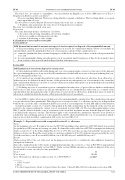Page 535 - SAIT Compendium 2016 Volume2
P. 535
IN 60 Income Tax acT: InTeRPReTaTIon noTes IN 60
The word ‘loss’, in contrast to ‘expenditure’, was described in the English case of Allen (HM Inspector of Taxes) v Farquharson Brothers and Co as follows:*
‘A loss is something different. That is not a thing which he expends or disburses. That is a thing which, so to speak,
comes upon him ab extra.’
The New Shorter Oxford English Dictionary† de nes the word ‘loss’ as follows:
‘1. Perdition, ruin, destruction, the state of fact of being destroyed or ruined.’ The term ‘loss’ includes the theft of an asset.
Destruction
The same dictionary de nes ‘destruction’ as follows:
‘1. the action of destroying, demolition, devastation, slaughter. 2. the fact or condition of being destroyed; ruin.
3. a means of destroying; a cause of ruin.’
4.2 Limitation of losses under section 20B Section 24M (1)
Section 20B
24M Incurral and accrual of amounts in respect of assets acquired or disposed of for unquanti ed amount
(1) If a person during any year of assessment disposes of an asset for consideration which consists of or includes an
amount which cannot be quanti ed in that year of assessment, so much of that consideration as—
(a) cannot be quanti ed in that year must for purposes of this Act be deemed not to have accrued to that person in that
year; and
(b) becomes quanti able during any subsequent year of assessment must for purposes of this Act be deemed to have
been accrued to that person from that disposal in that subsequent year.
20B Limitation of losses from disposal of certain assets
(1) Any deduction which is allowable during any year of assessment under section 11(o) in respect of the disposal
by a person during that year of any asset the full consideration of which will not accrue to that person during that year, must be disregarded in that year.
(2) So much of any amount disregarded in terms of subsection (1), which has not otherwise been allowed as a deduction, may be deducted from the income of that person in any subsequent year of assessment to the extent that any consideration which is received by or accrued to that person in that subsequent year from that disposal is included in the income of that person.
(3) If during any year of assessment a person contemplated in subsection (1) proves that no further consideration will accrue to him or her in that year and any subsequent year as contemplated in subsection (2), so much of the amount which was disregarded in terms of subsection (1) as has not been allowed as a deduction in any year, must be allowed as a deduction from the income of that person in that year of assessment.
Section 24M (1) applies when an asset is disposed of for an unquanti able consideration. The consideration is deemed to accrue when it becomes quanti able. This can give rise to a larger section 11 (o) allowance in the year of disposal than would be the case if the entire consideration had been received or accrued up front. Section 20B addresses this situation.
A deduction under section 11 (o) must be disregarded if the full consideration for the disposal of the asset has not accrued to the taxpayer during the current year of assessment [section 20B (1)]. The loss disregarded under section 20B (1) will be allowed in future years of assessment to the extent that any future income from the disposal of the asset is included in the taxpayer’s income. This will not apply to the extent that the amount has otherwise been allowed as a deduction. Any remaining portion of a disregarded loss will be allowed in full in the year of assessment in which a taxpayer proves that no further consideration will accrue [section 20B (3)].‡
Example 3 – Depreciable asset with a suspended section 11 (o) allowance
Facts:
At the beginning of year 1 B acquired an asset for R57 000 (including value-added tax of R7 000) which was used in the production of B’s income in carrying on a trade. B claimed the value-added tax of R7 000 as an input tax deduction under section 16 (3) of the Value-Added Tax Act 89 of 1991. The asset has an expected useful life for income tax purposes of six years. B used the asset for three years before selling it to C for 5% of the income generated by the asset over the next three years. B received R10 000 in year 4, R5 000 in year 5 and R6 000 in year 6.
Result:
Under section 23C (1) the cost of the asset for the purposes of section 11 (o) excludes the value-added tax claimed as an input tax deduction.
Since the consideration due to B consists of unquanti ed amounts, the section 11 (o) loss of R25 000 is suspended in the rst year of assessment under section 20B (1). Under section 24M the amounts receivable on disposal of the asset are deemed to accrue once they become quanti able.
Year 3
Cost of asset
Less: Wear-and-tear allowances under section 11 (e) R50 000/6 x 3
* 17 TC 59 at 64.
† Above.
‡ See the Comprehensive Guide to Capital Gains Tax (Issue 3) dated 6 May 2010 for a discussion of section 20B.
R 50 000 (25 000)
saIT comPendIum oF Tax LegIsLaTIon VoLume 2 527


